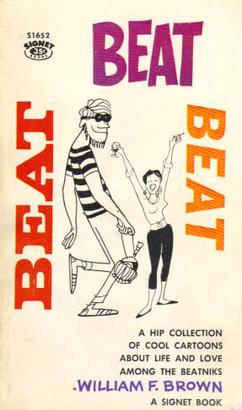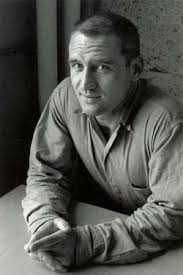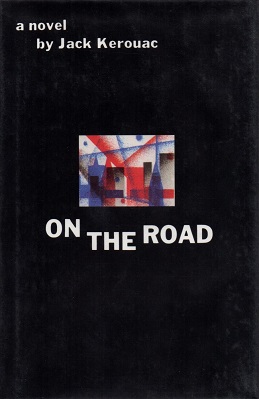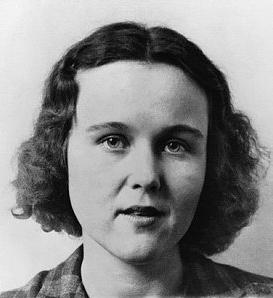
Jean-Louis Lebris de Kérouac, known as Jack Kerouac, was an American novelist and poet who, alongside William S. Burroughs and Allen Ginsberg, was a pioneer of the Beat Generation.

William Seward Burroughs II was an American writer and visual artist, widely considered a primary figure of the Beat Generation and a major postmodern author who influenced popular culture and literature. Burroughs wrote eighteen novels and novellas, six collections of short stories and four collections of essays, and five books have been published of his interviews and correspondences; he was initially briefly known by the pen name William Lee. He also collaborated on projects and recordings with numerous performers and musicians, made many appearances in films, and created and exhibited thousands of visual artworks, including his celebrated "Shotgun Art".

Beatniks were members of a social movement in the 1950s and early 1960s who subscribed to an anti-materialistic lifestyle. They rejected the conformity and consumerism of mainstream American culture and expressed themselves through various forms of art, such as literature, poetry, music, and painting. They also experimented with spirituality, drugs, sexuality, and travel. The term “beatnik” was coined by San Francisco Chronicle columnist Herb Caen in 1958, as a derogatory label for the followers of the Beat Generation, a group of influential writers and artists who emerged in the late 1940s and early 1950s. The name was inspired by the Russian suffix “-nik”, which was used to denote members of various political or social groups, such as “Sputnik”. The term “beat” was originally used by Jack Kerouac in 1948 to describe his social circle of friends and fellow writers, such as Allen Ginsberg, William S. Burroughs, and Neal Cassady. Kerouac said that “beat” had multiple meanings, such as “beaten down”, “beatific”, “beat up”, and “beat out”. He also associated it with the musical term “beat”, which referred to the rhythmic patterns of jazz, a genre that influenced many beatniks.
The Beat Generation was a literary subculture movement started by a group of authors whose work explored and influenced American culture and politics in the post-war era. The bulk of their work was published and popularized by Silent Generationers in the 1950s, better known as Beatniks. The central elements of Beat culture are the rejection of standard narrative values, making a spiritual quest, the exploration of American and Eastern religions, the rejection of economic materialism, explicit portrayals of the human condition, experimentation with psychedelic drugs, and sexual liberation and exploration.

Neal Leon Cassady was a major figure of the Beat Generation of the 1950s and the psychedelic and counterculture movements of the 1960s.

Naked Lunch is a 1959 novel by American writer William S. Burroughs. The book is structured as a series of loosely connected vignettes, intended by Burroughs to be read in any order. The reader follows the narration of junkie William Lee, who takes on various aliases, from the U.S. to Mexico, eventually to Tangier and the dreamlike Interzone.

On the Road is a 1957 novel by American writer Jack Kerouac, based on the travels of Kerouac and his friends across the United States. It is considered a defining work of the postwar Beat and Counterculture generations, with its protagonists living life against a backdrop of jazz, poetry, and drug use. The novel is a roman à clef, with many key figures of the Beat movement, such as William S. Burroughs, Allen Ginsberg, and Neal Cassady represented by characters in the book, including Kerouac himself as the narrator Sal Paradise.

Joan Vollmer was an influential participant in the early Beat Generation circle. While a student at Barnard College, she became the roommate of Edie Parker. Their apartment became a gathering place for the Beats during the 1940s, where Vollmer was often at the center of marathon, all-night discussions. In 1946, she began a relationship with William S. Burroughs, later becoming his common-law wife. In 1951, Burroughs killed Vollmer. He claimed, and shortly thereafter denied, the killing was a drunken attempt at playing William Tell.

The Subterraneans is a 1958 novella by Beat Generation author Jack Kerouac. It is a semi-fictional account of his short romance with Alene Lee (1931–1991), an African-American woman, in Greenwich Village, New York. It was the first work of Kerouac’s to be released following the success of On the Road. The Subterraneans and its following novel,The Dharma Bums, both proved to be popular when released in 1958, and are now seen as important works of the Beat Literature. A Hollywood film adaptation would be released in 1960.

Herbert Edwin Huncke was an American writer and poet, and an active participant in a number of emerging cultural, social and aesthetic movements of the 20th century in America. He was a member of the Beat Generation and is reputed to have coined the term.

Janet Michelle "Jan" Kerouac was an American writer and the only child of beat generation author Jack Kerouac and Joan Haverty Kerouac.

Junkie: Confessions of an Unredeemed Drug Addict is a novel by American beat generation writer William S. Burroughs, initially published under the pseudonym William Lee in 1953. His first published work, it is semi-autobiographical and focuses on Burroughs' life as a drug user and dealer. It has come to be considered a seminal text on the lifestyle of heroin addicts in the early 1950s.

Queer is an early short novel by William S. Burroughs. It is partially a sequel to his earlier novel, Junkie, which ends with the stated ambition of finding a drug called Yage. Queer, although not devoted to that quest, does include a trip to South America looking for the substance.

Lucien Carr was a key member of the original New York City circle of the Beat Generation in the 1940s; later he worked for many years as an editor for United Press International.

Joyce Johnson is an American author of fiction and nonfiction. She was born Joyce Glassman in 1935 to a Jewish family in New York City and raised in the Morningside Heights neighborhood of Manhattan, a few blocks from the apartment of Joan Vollmer Adams where William Burroughs, Allen Ginsberg and Jack Kerouac lived from 1944 to 1946. She was a child actress and appeared in the Broadway production of I Remember Mama, which she writes about in her 2004 memoir Missing Men.

Desolation Angels is a semi-autobiographical novel written by Beat Generation author Jack Kerouac, which makes up part of his Duluoz Legend. It was published in 1965, but was written years earlier, around the time On the Road was in the process of publication. The events described in the novel take place from 1956-1957. Much of the psychological struggle which the novel's protagonist, Jack Duluoz, undergoes in the novel reflects Kerouac's own increasing disenchantment with the Buddhist philosophy. Throughout the novel, Kerouac discusses his disenchantment with fame, and complicated feelings towards the Beat Generation. He also discusses his relationship with his mother and his friends such as Allen Ginsberg, Neal Cassady, Lucienn Carr and William S. Burroughs. The novel is also notable for being a relatively positive portrayal of homosexuality and homosexual characters, despite its use of words that were at the time considered homophobic slurs.

And the Hippos Were Boiled in Their Tanks is a novel by Jack Kerouac and William S. Burroughs. It was written in 1945, a full decade before the two authors became famous as leading figures of the Beat Generation, and remained unpublished in complete form until 2008.

Mexico City Blues is a long poem by Jack Kerouac, composed of 242 "choruses" or stanzas, which was first published in 1959. Written between 1954 and 1957, the poem is the product of Kerouac's spontaneous prose technique, his Buddhist faith, emotional states, and disappointment with his own creativity—including his failure to publish a novel between 1950's The Town and the City and the more widely acclaimed On the Road (1957).
Jack Kerouac was an American novelist and poet. He is considered a literary iconoclast and, alongside William S. Burroughs and Allen Ginsberg, a pioneer of the Beat Generation. Kerouac is recognized for his method of spontaneous prose. Thematically, his work covers topics such as Catholic spirituality, jazz, promiscuity, Buddhism, drugs, poverty, and travel. Kerouac used the name "Duluoz Legend" to refer to his collected autobiographical works.
Haldon Chase, often referred to as "Hal Chase", was a Denver-born archaeologist, who was known for his archaeological research on several rock art sites at Colorado. Outside the field of archaeology, he was best known as part of the earliest Beat circle.
















